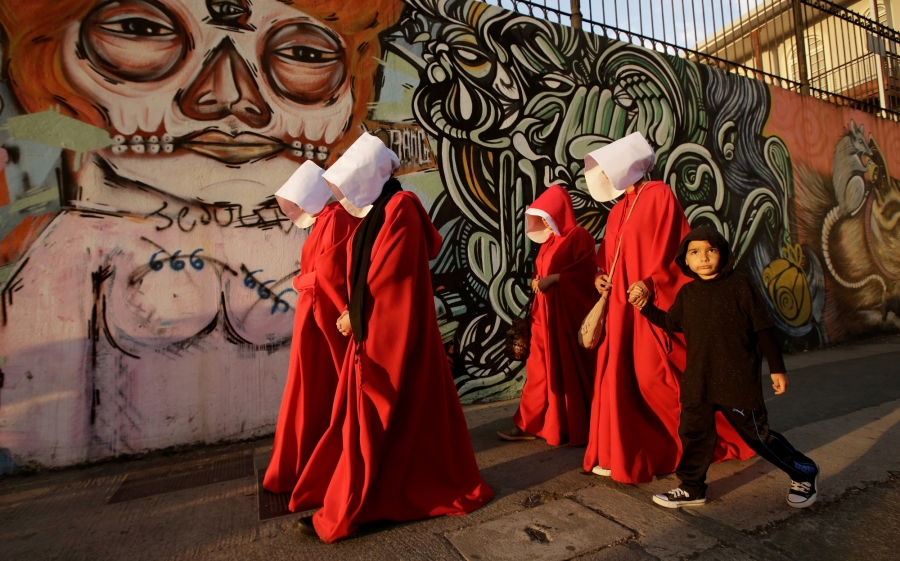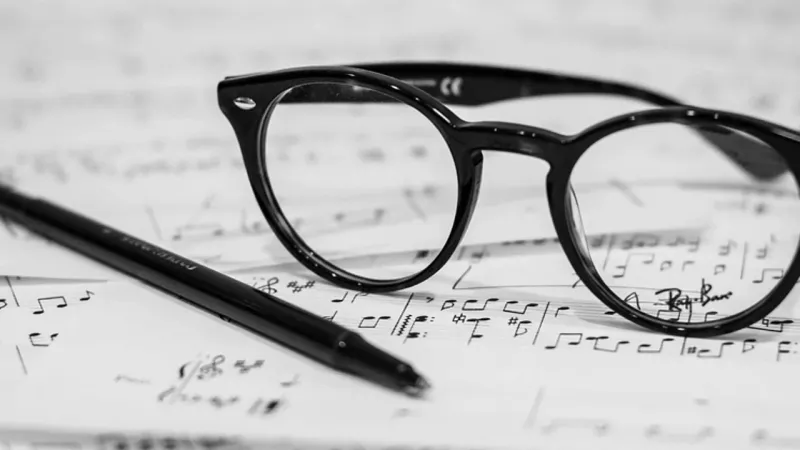Every now and then, someone will ask about favorite books, the ones you’ve re-read repeatedly. Books that influenced your life. Answers often range from classics (‘Little Women’) to the Bible. I have my own list of a dozen or so—but it’s easy for me to share the book that most influenced my life: The Handmaid’s Tale.
I like what the Washington Post said about it in an early review: Published in 1985, this is a novel of such power that the reader is unable to forget its images and its forecast. It is at once scathing satire, dire warning, and tour de force. “A novel that brilliantly illuminates some of the darker interconnections between politics and sex.”
Darker interconnections, indeed.
When I first read the book (sometime in 1986, shortly after it was published), I was a new mother; my baby daughter was born in 1985. I was also a full-time teacher, with a 45-minute commute, who didn’t have a lot of time for pleasure reading or meandering trips to the library.
I had, however, read and liked Surfacing, one of Atwood’s early works that was on many short lists of early feminist reading—The Golden Notebook, Yellow Wallpaper, The Bell Jar, and the like, those now-classic novels about women figuring out how the world works. I checked Handmaid out from the library, and hoo boy—that book was one powerful, dystopian reading experience.
Some years later, I read an interview with Atwood (by then, one of my favorite authors), where she noted that there is real-life precedent for everything in Handmaid’s Tale. This truth re-emerged when Hulu created a TV series based on the book in 2017, and viewers commented on the dark and violent nature of the story—I can’t watch! It’s too violent! And totally unrealistic! Umm—nope.
Lest you think I was a raging, underwear-torching feminist back then—hardly. I was happily married, and embarrassingly grateful for my low-wage, womens-work career as a teacher. I went to exactly one consciousness-raising meeting, and came home with a headache, thinking that these women were whiners who needed to solve their own problems rather than waiting for The Movement to change their lives.
And yet. All the way back to my first day as a band teacher, in 1975, I knew that it was a man’s, man’s etc. world, and the power in K-12 education was firmly in male hands. Although the percentage of women who hold down K-12 teaching positions has steadily increased since the 1960s, I was in a heavily male-dominated subset of teachers: band directors. In the late 70s, working on my masters thesis, I acquired the mailing list of all secondary instrumental music teachers in MI. There were seven women holding down HS band jobs in the entire state, somewhere between one and two percent.
That number has slowly, gradually shifted—but it’s taken forty years, and we’re not anywhere near parity yet. I have dozens of humiliating stories about being the only soprano in a room full of tenors and basses, the designated secretary and coffee-maker at professional meetings. Some of them still hurt. Occasionally, on social media, a female band director will share a story about inappropriate remarks made by a male colleague—and there will still, still be men who defend the other man as ‘well-meaning.’
All of this reminds me of a passage in Handmaid’s Tale where Offred–June, for those who know the TV series—reminisces about the day her bank account is frozen, and her husband Luke says not to worry, he’ll take care of her. And he intends to—because he means well. Luke, Offred thinks, is a little too sanguine about all of this—and he’s one of the good ones.
Being a woman in a male-dominated profession was a lot of that operating assumption: good relationships with men were the key to a productive educational work life. If your principal liked you, or your male band-teacher colleagues liked you, you were probably fine. Underestimated, misjudged and overlooked, perhaps. But they’d be polite and friendly, as long as you were no threat to their presumed superiority in a competitive education arena.
A lot of the sexism in education flies way under the radar. It’s subtle. So subtle that the people who are exposing it in their own behavior don’t see their own words and actions as sexist. This cluelessness is not surprising. Unrecognized, unacknowledged sexism is everywhere—in politics, media coverage of current events, everyplace from childbirth practices to cooking.
And paying attention to it matters, a lot, if we care about raising healthy children and building healthy cities.The current debates on transgender students, for example, are rooted in sexism (and, it could be argued, violence):
Supporters of [a bill to prevent transgender students from participating in sports] heavily centered their arguments around athletic differences between cisgender women and cisgender men. Gabriel Higerd, a former adjunct professor of exercise science who researches transgender sports policy, said “biological females are one of our nation’s greatest treasures” and argued that this bill is necessary because it protects cisgender female athletes from competing against transgender female athletes. I have never heard any single group of Americans described as “one of our nation’s greatest treasures” as if they were some sort of commodity and not human beings.
And there you go: Biological females, a great treasure to our nation. We’re back in 1985—or 1947, as women (white women) were forced out of the post-war job market and persuaded their place was in the home, caring for as many children as they could bear. Go back as far as you like. You’ll find sexism. Atwood took us to a place in a not-distant future when men acted on the principle of female fertility being a ‘great (and biblically designated) treasure.’ Not hard to fathom, at all.
I am a big fan of the beautifully filmed Handmaid TV series which uses Atwood’s book as starting point, and of her sequel novel, The Testaments. I did not re-read Handmaid for 30 years. When the series was announced, I bought a digital copy. I remembered all kinds of things about the characters, passages of text, the plot and the utterly chilling world that Atwood created: Gilead. It rang true—or at least possible—in 1986, and just as plausible, if not more so, in 2016.
I also know that every time I have written a blog, over the past 17 years, about how women and their talents have been suppressed in EdWorld, I have received pushback. Some of it has been downright ugly.
Which is why I don’t pay attention to reviewers who think that Handmaid’s Tale, focused more and more about savage retribution in Season 4, has jumped the shark. I prefer to think of it as cautionary tale.
Watch—or read—and learn. What goes around, comes around.


In 2010 our son Sam (now our daughter, Scarlet) had to design a project around Handmaid’s Tale for English class. She summarized each chapter in a tweet. Margaret Atwood followed those tweets. Our daughter won a statewide writing competition in a whole new category created for her work.
I had read Handmaid’s Tale in 1986, again with my child, and most recently before I watched the first season on Hulu because I was concerned about authenticity. I never doubted the possibility of this particular dystopia, but I was struck by the crushing need of Scarlet to embrace her womanhood in spite of the very real discrimination faced by women everyday in the land of the free, home of the brave. Brave indeed-every American who is not male, white, and economically secure. Thanks, Nancy.
LikeLiked by 1 person
Thanks for an amazing comment, Jackie.
LikeLike
Re “I also know that every time I have written a blog, over the past 17 years, about how women and their talents have been suppressed in EdWorld, I have received pushback. Some of it has been downright ugly.”
This is appalling. My ex-wife and I were in graduate school working on master’s degrees in chemistry and I had to sit in plain site outside the graduate advisor’s office door every time she had an appointment. The jerk had the temerity to ask her “why a housewife wanted a graduate degree in chemistry.” The fact that she had a BS in chemistry and was admitted to his school and department apparently didn’t cross his mind.
The patriarchy in education was alive and well in the early 1970’s when that happened and is still alive today, albeit slightly diminished.
LikeLike
Another amazing comment. Thanks.
LikeLike
The Handmaids’ Tale is stunning TV, dark, scary and full of insights for our times. As a 70 year old twin, I’ve been witnessing my sisters struggles with limiting gender roles since her protests about having to wear a skirt to kindergarten. Sometimes getting outraged and angry is what’s needed.
But change is slow and I’ve also been struck by how often powerful women bring humor to their confrontations with stupid barriers. I’m reminded of Vera Rubin the astronomer, who being invited to work at the Palomar Observatory arrived to be warned that there were no women’s restrooms to use during all-night observations. Rubin responded with characteristic creativity. She cut out a paper skirt and pasted it on the male figure on one of the Men’s room doors, remarking, “There you go, now you have a Ladies’ room.”
Rubin often spoke of the discrimination she’d faced, starting with the macho high school physics teacher who, hearing she’d been accepted to college told her, “You should do OK as long as you stay away from science.” And Rubin also told another school story full of insights for educators. She says, “Also while in high school, I wanted to take a class in mechanical drawing, a class that was given in the boys’ wing of the school, near the wood shop and metal shop. I was smart enough to talk a girl friend into joining me, because the prospect of going alone scared me. We completed the course, with great enjoyment and some ability, and I still make most of my own figures for my papers.”
Who could have imagined where Rubin’s small success in mechanical drawing would take her? After all, her “figures” were the heart of her work, turning data into pictures that revealed the movements of galaxies. As James Peebles, the 2019 Nobel winner said, “The visual impression of Vera’s work was so striking that it just leapt to the eye. We shouldn’t underestimate the power of an image and her images were stunning.”
I hope her mechanical drawing teacher got to hear about Rubin’s amazing picture making.
LikeLike
That’s an INCREDIBLE story–mechanical drawing as stepping stone to astronomy. Makes me embarrassed for all the things I took for granted, in 30+ years in the classroom, and all the missed opportunities to tell girls things like: Did you ever think of taking mechanical drawing?
LikeLike
You are right, Rubin’s path from mechanical drawing to astrophysics does seem “INCREDIBLE.” That’s the territory I’m currently researching. Hoping to send you more of Rubin’s little told story if you are curious. Rogessley@gmail.com.
LikeLike